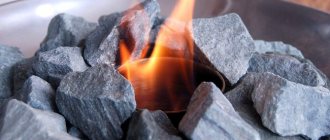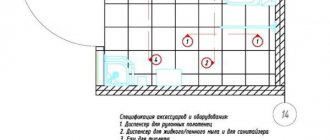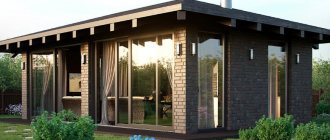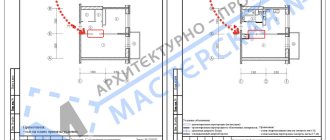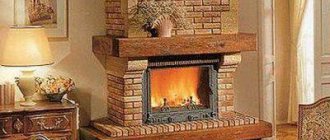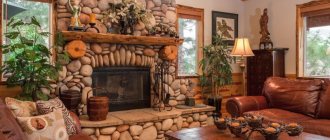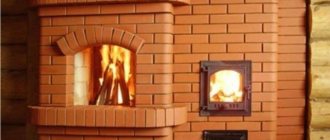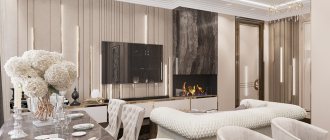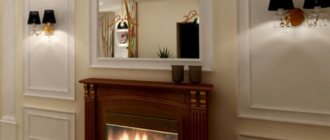Over the course of previous centuries, the stove was the basic, symbolic definition of the family hearth. Thanks to this element, the home creates an atmosphere of convenience, relaxation, relaxation after a hard day or week (if you live in the city and only come here on weekends). Many owners of their own homes located outside the city strive to settle down in a cozy place in the winter in the evening, communicate with family and friends in a comfortable environment conducive to intimate conversations.
Diagram of the relationship between the size of the fireplace and the room.
In addition, the stove is a very positive element of interior decoration, which will definitely decorate and warm the room in which it is located. This heating element has many advantages, but before you start building this type of stove with your own hands, you need to plan it correctly and decide on your financial capabilities (after all, the cost of building a fireplace is not so small). Thus, the design of the fireplace, in addition to direct construction operations, also provides for some other features.
Financial characteristics of the fireplace design
The amount of money that you are willing to spend on construction may sometimes not coincide with the actual amount that is needed to build a fireplace. The main components that determine how much you need to spend are the following:
Diagram of fireplace proportions.
- the type of fireplace design and the method by which its external finishing will be done;
- the dimensions of the room, especially how far from the floor the ceiling is, and how many floors there are in the house;
- materials from which the walls are made, both load-bearing and interior partitions;
- features of the materials from which the foundation of the house is constructed;
- features of the approximate location of this piece of furniture;
- atmospheric features of the territory on which the house is located (after all, a fireplace does not always act as a heating equipment; sometimes it simply becomes an item necessary to create a warm and romantic mood).
Approximately complete installation of a brick fireplace with cladding, if the pipe diameter is in the range of 2-2.5 m, in a small two-story building will cost approximately 50 thousand rubles. In order for the resulting fireplace design to be not only beautiful, but also comfortable, you need to take into account the numerous stages of this event.
Open or Alpine (Swiss)
This type of fireplace has become popular only recently. In fact, this is also not a fireplace in its pure form, but for a different reason. Rather, it is simply an open or semi-closed hearth, over which a cap is made that turns into a chimney.
An Alpine or Swiss fireplace has a memorable appearance
It fits perfectly into chalet-style interiors, because that’s where it came to us. The device, in general, is simple, but not very efficient in terms of heating. But it is very decorative.
The option that you see in the photo above is made in a rustic style - made of natural processed stone. Such work costs a lot of money: you have to adjust and trim hard rocks, which requires a high level of skill.
Installation of brick fireplaces
This component consists of only two, but the most important structures. This is the firebox and chimney. The first of the listed parts is the most basic part of the fireplace; to some extent, this is its basis, ensuring the operation of the entire complex heating system. The chimney maintains air circulation and supplies the fire with the oxygen it needs. This is facilitated by the correct design of the chimney. But in addition to the fireboxes and chimney, fireplaces also contain a number of elements and details. Among them:
Table of recommended fireplace sizes.
- heat exchanger;
- chimney;
- a valve located near the grate;
- ash pan;
- grate mesh;
- lining - the internal lining of the furnace, which is made of durable heat-resistant brick;
- doors and dampers that perform protective functions.
On the outside, each fireplace has only 2 components, known to everyone. This is the entrance to the firebox and the lining. The entrance is a certain decorative element of the stove firebox, which represents and shapes the exterior of the stove.
The fireplace covering is the external treatment of both the fireplace itself and the chimney with various finishing materials, which also characterize the external type of this interior element.
Classic English
Appearance of a classic fireplace
A traditional fireplace the way we imagine it. An open wide portal of the firebox in which firewood is burning. Moreover, its decoration can be anything, either elaborate to suit the corresponding interiors, or discreet, which fits into high-tech and minimalism.
Despite the fact that it doesn’t seem to take up very much space, it will take about 800 bricks to make a classic fireplace along with an average-length chimney. The total mass of such a structure is around a ton. The smallest classic fireplace requires a solid separate foundation, like the one for a stove - to the same depth as the foundation of the house, and in size it should be larger on all sides by at least 15 cm. Bring it to one level with the floor.
Device and how it works
Classic fireplace in section
If you look at the photo, it seems that there is nothing complicated: a box with a pipe and that’s it. But what looks simple is actually far from simple. First, there is a smoke tooth at the top of the firebox. And not just any protrusion, but with a reflective surface. It narrows the cross-section of the pipe, twisting the flame inside the firebox.
Secondly, the bottom part of the fireplace insert does not have a vent, and the front wall is made with an inward slope. These two components make it possible to ensure that the flame spins in the firebox for a long time, giving off maximum heat.
Thirdly, there is a damper in the pipe, which effectively and, very importantly, safely regulates the intensity of combustion. Safe - because a properly built fireplace under no circumstances produces carbon monoxide in quantities hazardous to health. After all, it is formed when there is a lack of oxygen, and with the portal of a classic fireplace open, there is always enough air and oxygen.
Another point of the fireplace view is that, like in a slide damper, a hole is cut out in it, with an area equal to 10% of the chimney cross-section. This gap is necessary for minimal draft, which in any case will not allow the flames and smoke to “fall out” of the firebox. Even with the damper closed, the fire spins inside and the smoke goes up the chimney.
This design allows for efficient use of heat even when burning high-calorie fuel. The long-rotating flame heats up the walls of the firebox to the maximum, and they perfectly heat the room.
If we talk about the possibility of heating water, then it is not possible to put anything in the firebox: all dynamics are disrupted. But above the tooth on the pipe, you can install a heat exchanger. Another question is that the temperatures there are no longer so high and it will not be possible to heat water for heating, but for domestic hot water in a small volume (storage type boiler), there will be enough heat.
In the earliest English fireplaces, the hearth was without a grate, sloping outward. At the same time, the slightest inaccuracy in execution led to the flame beginning to rotate in the other direction. At the same time, coals could fly out of the firebox, which is not at all good. Therefore, in the Middle Ages, they began to make small grates and a blower, which were opened only during kindling. When the wood flares up, the ash pan closes, which gives impetus to the formation of a fiery whirlwind in the firebox.
Modern English fireplaces are made with both a solid hearth and a grate. When lighting blind models, kindling liquids are used when igniting. They themselves provide sufficient impulse for the formation of a vortex.
Drawing of a classic English fireplace with dimensions
Arranging a classic fireplace
Traditional English fireplaces are structurally different from each other in the shape of the smoke tooth. To accurately reproduce it, only “straight hands” is not enough. It requires experience and a lot of it. But there are models that are not so critical to this detail. You can build such a fireplace with your own hands if you know how to handle a trowel and a level.
Simple classic fireplace: arrangement
In this option, the grate is small in size and located at the very end of the firebox. This made it possible not to play tricks with the tooth, but to make it ordinary, stepped. But in this fireplace, the vent cannot be closed during lighting. The fire “spinning” is precisely due to the flow of air into the rear part of the firebox.
Rumford fireplace
One of the classic varieties is called the Ramfod (Rumfoord) fireplace. The principle of operation is the same, only the swirl is provided not by the smoke tooth, but by the narrowed neck of the chimney, the shape of which repeats one of the branches of the hyperbola.
Rumford fireplace. The key unit is the pipe neck
Structurally, it is simpler and requires less space - the firebox can be less deep. The problem is that the neck must be made with very high precision. A deviation of only 5% from the required shape leads to inoperability. This is the main difficulty, therefore we do not recommend making this fireplace with your own hands.
Features of determining dimensions and location
According to the type and method of location, all fireplaces are divided into several groups:
Scheme of a wall-mounted fireplace.
- Wall-mounted. The system of such a fireplace is located against the wall; usually this household item has impressive volumes and can be either partially or completely installed in the wall. It is permissible to build this type of fireplace at the stage of housing construction, but you can make a niche in the wall after the house is built. In the latter case, additional work will have to be carried out to redevelop the premises located next door. Belongs to the most famous type of fireplaces. The chimney must be attached to a load-bearing fire-resistant wall (for this it must be treated with a special fire-resistant agent).
- Corner designs are considered one of the most beautiful and attractive types of fireplaces. A similar form is placed in the corner of the room. The chimney of this type of fireplace is designed in one of the nearby walls. Creating corner fireplaces is no more difficult than many other varieties; here it is necessary to thoroughly do the preparatory design, examine the foundation of the house and determine the condition of the load-bearing walls.
- The built-in structure is completely mounted in a wall niche or in a column and covers the minimum area of the room. It is advisable to begin the construction of such structures at the stage of housing construction.
- Free-standing stoves are a type of so-called island fireplaces in the form of a straight platform rising above the foundation.
Diagrams of the fireplace from some angles: from above, from the side, from the front (Fig. 1) and in section (Fig. 2).
Fireplaces, according to observations, both before and now are usually installed near the main, load-bearing wall of the home. At the same time, it must be remembered that freezing and blowing out of the firebox and its outlet is unacceptable in this case. If the fireplace is in a draft, for example, next to stairs or in a corridor, in a room of less than 20 square meters, then you will have to constantly monitor the heating process to prevent possible attenuation or, conversely, excessive combustion. Close to the element being built, it is necessary to provide the ability to easily approach the fireplace so that at any time in this area you can organize an entertainment area or simply place a chair closer to bask under a soft blanket with a cup of coffee or while reading a book. Before designing a fireplace, you need to check the load-bearing performance of the floor and foundation of the house. When designing a base for a fireplace, you need to compare the distribution of the pipe with the supports and rafters of the roofing system.
The base must be made of fire-resistant materials. If the house is made of wood, you need to carry out several actions in accordance with the rules for ensuring the safety and safe operation of heating equipment. It is necessary to treat both the stove itself with such materials (to avoid getting too severe burns) and the interior items around it. So, from the firebox to the building elements (walls, furniture and other flammable objects), it is necessary to use special materials. It’s better to make sure that there is a distance of at least 80 cm from the stove to all this.
Getting permission
A little about whether to order a fireplace installation from a company or do it yourself. This is not just about the technical side of the issue. Usually, difficulties arise long before this - even during the preparation of documents. Firefighters really don’t like to give permission for fireplaces. And permits are required when installing a fireplace in any residential premises. The difficulty is that there is no legislative framework that would prescribe installation rules. There is a similar document for stoves, but not for fireplaces. But there is a phrase in SNiP 2.04.05-91 (on the design of heating and cooking stoves) that the installation of heating devices with an open firebox is prohibited in any residential premises. From this point of view, you are lucky if you plan to make a fireplace at a dacha located in a holiday village - it is not considered a residential premises.
As often happens, there is another document (MGSN 3.01-96), which in Moscow allows the installation of fireplaces on the top floors if there is only one owner. So in the capital, there is a chance to get permission, although not everyone has it.
There is also a loophole for residents of old brick Stalin buildings and Khrushchev buildings, in which, in addition to ventilation ducts, each apartment also has chimneys. Houses of modern construction, which also have smoke ducts, fall under the same category. In all these buildings it is allowed to install heating equipment on a flame. In general, a stove is implied, but this fact is not stated anywhere.
One of the possible options for designing a fireplace in a modern style
You can “push through” the permit by filling out the paperwork for a complex redevelopment with the transfer of heating appliances. An example is the transfer of walls, partitions, combination with a balcony or loggia. In papers, do not write about registers or central heating radiators. It is in this general formulation that heating appliances are used. In the same document you enter that you are going to install a heating device on a flame, attaching a project made in a design organization. In this case, homemade papers do not pass. There is a chance. But in general, the owners of houses and apartments will be persecuted for a long time and persistently. And don’t try to argue, otherwise you’ll never get permission. Rework everything they require. There is no other way. It will be a little easier for home owners. The logic is clear - if problems arise, you will burn yourself. They speak harshly to apartment owners, but you can still get permission.
Now, if you don’t want to deal with all this, you can order the installation of the same fireplace with a firebox from a specialized organization. Typically, they provide documentation services. They have already trodden paths, the chances are much greater. In addition, upon acceptance of your heating device, they may (and most likely will) require certificates for all materials, including bolts, screws and stove fittings. You also need to know and remember this. And with such a task, buying materials turns into a difficult quest.
Option for a brick fireplace in the corner
Fireplace drawings and diagrams
Before building a fireplace without the help of others, it is permissible to draw up drawings on an appropriate scale. The diagrams are made from several angles - from above, from the side, from the front (Figure 1) and in section (Figure 2). The presence of drawings greatly simplifies not only the construction procedure, but also the process of calculating the necessary building and facing materials. The main details that you need to focus on when drawing up fireplace drawings are presented below:
Rice. 3. Fireplace arrangement diagram.
- Calculation of the base of the stove and its connection with the existing foundation of the house.
- Diagram of the opening in the ceiling and roof structure.
- Calculation of building and facing materials.
- Development of external design.
- Calculation of heat transfer.
- Ordering (Figure 3).
- Explication and ease of future use.
- Safety and fire resistance.
Many specialists, even with extensive experience working with stoves and fireplaces, never begin without drawing an order, a detailed diagram in which the position of each brick in the masonry is specifically disassembled and marked. When building a fireplace for the first time, the order should be created under the guidance of an experienced stove maker.
To build a brick stove or fireplace, you need the following materials:
- Red brick;
- sand;
- bottle;
- crushed stone;
- cement, etc.
Rice.
4. Layout of the fireplace. Red brick is purchased of good quality (usually fireclay), there should not be any defects in it, the structure of the stone should be uniform, the shape should be correct with right angles and smooth surfaces. Each brick is preliminarily examined, for which you need to knock on it with a hammer; this action should produce a ringing noise. If the brick has gone through at least a minor, superficial industrial temperature treatment, then its color will be much brighter and its edges will be smoother. After tapping with a hammer, you will need to select only those bricks that pass the test (poor quality brick will make a quiet dull noise, which means that it has not been fired). Some properly treated bricks have a dirty or grayish color.
Typically, one medium-sized fireplace requires about 250-300 bricks, excluding the construction of a chimney. For the solution you will need:
- clay;
- sand;
- cement.
You need about half a cubic meter of clay, neutral cement, grade 200 or 300, will be useful. The sand for the mortar for laying the fireplace can be fine and medium (up to 1.5 mm), there should not be anything extra in it - clay, branches, earth, stones. It may be required as much as clay, and if it is oily, then more - up to 0.8 cubic meters.
Cast iron option
Pursuing the goal of maximizing efficiency, not paying attention to the classic look of the fireplace, gave rise to the idea of creating cast iron devices. They have the same operating principle as a wood-burning fireplace, but some subtleties radically change the heat transfer parameters.
Cast iron firebox built into the system
- The firebox is made in the form of a separate cassette, which is mounted in the fireplace body. A space is created between the firebox and the body for air circulation. Thus, intense heating of air masses occurs, which then fill the entire space of the room.
- The walls of the firebox are made of cast iron. It is able to quickly absorb heat and transfer it to convection air flows. Despite the fact that such a fireplace stops heating the room after burning the fuel, during its operation it has a high (up to 80%) efficiency.
- The chimney is made of metal pipes, which greatly facilitates the independent installation of a fireplace.
Preparing materials for laying a fireplace in advance
Table of compositions of mortars for laying stoves and fireplaces.
The clay is pre-prepared, moistened in small pieces for several days (2-3). The soggy clay is filtered through a steel mesh, the cells of which are approximately 3-5 mm in diameter, after which the clay is mixed with thoroughly cleaned and dried sand, then water is added to the mixture. If the solution has still not reached the required concentration, you need to add some cement to it. There is no exact amount, so you need to determine it by eye, gradually adding and mixing the solution. The bricks are moistened right up to the start of laying: either one by one, each brick is dipped in water for a few minutes before laying, or a day before, but the whole brick at once. In this case, it is necessary to monitor whether bubbles appear on its surface. If so, then there is still air in it. It's worth waiting a little longer.
In addition to the material for laying the fireplace, you will need to prepare the following tools:
Technological tool for laying a fireplace.
- hacksaw and hammer;
- container for preparing the solution;
- bucket;
- a sieve with 1x1 mm cells to sift out cement;
- sieve with 2x2 mm cells - sift out sand,
- furnace hammer;
- Master OK;
- a plumb line to adjust the vertical evenness of the masonry;
- building level to adjust the masonry horizontally;
- square;
- jointing;
- roulette.
What you need to pay attention to.
Open fireboxes are laid out in place using a certain technology. Each master has his own secrets. Depending on the parameters of the chimney, the firebox has certain geometric proportions. Failure to comply with technical conditions can lead to poor-quality operation of the fireplace. There may be difficulties with kindling and smoke during operation. Open fireboxes are sensitive to lack of air in the room where the fireplace is installed. During installation, it is necessary to organize a flow of air for combustion. It is also advisable to provide an ash drawer and a grate for ease of use.
Construction of a fireplace
The foundation is constructed under the entire area of the future structure. Therefore, add 5-7 cm on each side so that the fireplace stands securely. Based on the resulting dimensions, you need to dig a pit no more than 20-30 cm deep. A layer of sand is placed on the bottom, and then a layer of crushed stone. All this is compacted. Next, you need to prepare a solution of sand, cement and water (ratio 3:1:1). The entire pit is filled to the top with this mixture. After this, it needs to dry for 1-2 days. As soon as this happens, you can move on to masonry.
The first row is laid completely, and starting from the second - only along the perimeter of the fireplace. The turns and narrowings of the gas threshold and chimney are rounded off. Further laying of the fireplace is carried out according to the diagram shown in Fig. 4. If you are laying ordinary decorative bricks on the outside, then the outer walls of the fireplace and the masonry inside are not tied with refractory bricks, so that due to the collision of different temperatures the integrity of the stove masonry is not compromised.
Style directions in design
Modern electric fireplaces are not limited in design.
There are a huge variety of beautiful models made in classic or modern styles. The market offers both simple models of floor-standing fireplaces and complex architectural designs of attached fireplaces. The design of side-mounted fireplaces can be completely under your control. You can choose the facing stone, the color and material of the shelf, and all the accessories. In addition, in all electric fireplaces, the hearth itself can have its own design. Here you can choose almost any material, from wood to marble.
7 photos
Installed in furniture pieces
Advanced technologies make it possible to harmoniously fit fireplace inserts into ready-made cabinets. This original solution decorates not only the room, but also the furniture set. The hearth is framed and mounted in a prepared niche. The idea of mortise-mounted household appliances has long been practiced in kitchen sets.
MDF or plastic from which furniture elements are made cannot but impose restrictions on the fireplaces built into them. This occurs due to the sensitivity of surfaces to temperature changes.
The built-in hearth should only serve as the illusion of fire. The most neutral and most successful option would be an electric fireplace without a heating function. Another alternative solution could be a built-in bio-fireplace, the heat from which is also minimal.
Non-trivial design solution
Summarizing the topic of classification, it should be noted that built-in fireplaces have characteristic advantages and disadvantages. Positive properties include ease of installation, the possibility of double-sided heating, stylish design, and space saving. The disadvantage is the need for a chimney and the inability to use the heating function of a fireplace built into the furniture.
In the interior of the living room
A wall-mounted electric fireplace is a simple and affordable way to add warmth and comfort to your living room. Installation won't require any major modifications, and most people can do the installation themselves since all you have to do is hang it on the wall and plug it in.
Below are some interesting and unusual ideas for installing an electric fireplace in the living room.
Wall-mounted electric fireplace above the sofa
One of the most popular ideas for creating a modern interior in the living room is installing a wall-mounted electric fireplace in the room above the sofa. A fireplace hanging in such a place will become the center of attention and create a comfortable, warm atmosphere in the relaxation area. Hosts and guests will be able to feel cozy and comfortable even on cold days.
Instead of TV
Currently, more and more people are turning off cable television, and some do not want a TV in their home at all. For this category of citizens, a wall-mounted electric fireplace can be a good replacement for a TV. This will create a beautiful focal point and a welcoming atmosphere.
Electric fireplace under the TV
If it is necessary to have both a TV and a fireplace, then you can install the device directly under the TV, because the electric fireplace model is safe to install under it, provided that the owners maintain the minimum recommended distance (30-60 cm).
Small electric fireplace in the living room
Wall-mounted electric fireplaces are great for placing on a small living room wall that is either painted a different color or has a design that stands out from the rest.
A fireplace serves as the centerpiece of any home or room, unifying its design and adding coziness and hospitality. For centuries, the hearth has symbolized bringing families together and welcoming strangers and neighbors. Models come in different shapes and styles, so these modifications are also perfect for apartments, because they bring warmth and comfort to the house and are an excellent addition to the home.
While traditional fireplaces can sometimes be difficult to maintain and expensive to maintain, modern electric fireplaces are the ideal solution for heating any room.
Versatility of the solution
Electricity has long replaced live flames in most household processes. Fireplaces were no exception. Thanks to the skillful imitation of flames and smoldering logs, such devices completely replace the aesthetic effect of real wood-burning fireplaces.
Thanks to the presence of heating elements, it is possible to use them as full-fledged heating devices.
A significant advantage of electric models over structures with live flames is:
- The absence of the need for a chimney system makes an electric built-in fireplace a real must-have for creating an atmospheric atmosphere in apartments and houses where there is no desire to bother with utilities.
- A mains-powered fireplace is much cleaner to operate - there is no carbon monoxide, soot, ash, or charcoal. You can even install it in the bedroom near the bed.
- Models operating under the control of an electronic controller have a wide range of settings: they can be used both to achieve a decorative effect and for heating purposes.
In terms of practicality, electric fireplaces are significantly ahead of another type of environmentally friendly device, where there are real flames when burning an alcohol-based composition. Biofireplaces are really beautiful, but non-functional - the heat they generate is insignificant.
How do they work?
A quality electric fireplace with an elegant design will create a realistic flame of fire that will radiate pleasant warmth. This touch will brighten up any living room.
Modern electric models use heating coils and silent fans that can produce real heat. They have a reflector installed that reflects the light from the LED lamps, creating a realistic flickering of the fire and the flame itself. LED lights replace real fire, but the flames look really realistic. Some electric models even have a special device installed that produces a crackling sound, which also enhances the effect.
When comparing traditional gas fireplaces to electric options, the running costs may not seem worth it. But here it is necessary to take into account the cost of not only installation, but also maintenance. In this fight, the electric model also wins, since significant maintenance costs are not required.
Portal decor for an electric fireplace
The decorative design of the electric fireplace portal can be anything. However, it should be remembered that in no case should it violate the integrity of the composition of the room, but only slightly shift the emphasis to the side. A good solution for decorating an object is to lay ceramic tiles, which will immediately make it elegant and natural. Moreover, installing the material on a flat plasterboard base is quite simple.
In addition, you can cover the building with structural plaster, wallpaper or paint, the main thing is that it is combined with other coatings and objects located in the room.
To achieve the desired effect, decorating the finished object is carried out based on the stylistic orientation of the entire room and only in accordance with it. This is the only way to be sure of obtaining a positive result, which will not only succinctly fit into the design of the room, but will also significantly embellish it.
To finish this article, check out the video: Modern electric fireplaces in the interior.
Perhaps after this you will like the electric fireplace even more.
